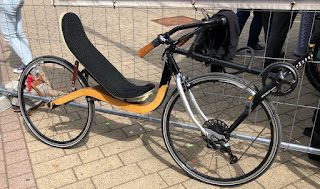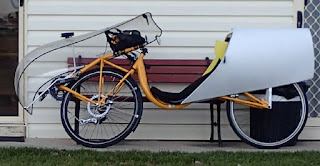Last year, I finished an industrial design master's degree at Monash University, and as well as documenting 6 leaning trikes I'd made during the study, wrote an entire thesis about them and what makes them tick. The thesis writing was actually all but finalised in December 2016 and didn't really include much about chain stress on recumbent bike frames, and minimising chain stress is part of what my designs do.
So sometime last year I started writing stuff about chain stresses in recumbents, and bounced some of the ideas off my friend George Durbridge. I written a draft by March 2017, emailed George, he wrote back, I then
Here is some of George's correspondence, this bit dates from March 12 2017, published with his permission
"Steve,
I'll drop off your paper, with a lot of illegible notes, and I expect
I'll see you tomorrow. In the meantime, a note on something you may
have taken for granted, but which a lot of readers will need help to
work out for themselves.
How great is the material cost of chain stresses, and what other costs
are there?
The material cost is low. Chain stress mainly appears as bending of the
frame in the vertical plane or, with your bikes, of the fork. There is
a secondary element of lateral bending, but it is clearly much less
than the vertical bending. Those elements of the frame have to be
strong enough to carry the weight of the rider, which acts in the same
direction, and is of the same order as the greatest force the rider
will repeatedly apply to the pedals. It must also withstand bumps,
which may easily reach 3g.
Chain stress is recurrent, so the frame must be overdesigned by a
factor of 3 to resist fatigue from millions of cycles (literally), but
3g bump stress is more or less one-off, with not much fatigue effect.
So the metal needed to resist chain stress is more or less the same, in
amount and location, as the metal already needed to resist bumps.
Obviously, one turn of the pedals (but not millions) may coincide with
a pothole, so the frame must be able to resist 4g (more or less) but
that's a small increment.
The fact that chain-stress appears mostly as vertical bending is
counter-intuitive to me, but it seems settled. Experiments show that a
round or square tube bends much more vertically than sideways under
chain stress. New (GT20) and old (Linear) designs of monotube recumbent
deal effectively with chain stress by using a deep but narrow main
tube. These are fast machines uphill, although your calculations
confirm my notion that such a frame is much weaker in lateral bending
than in vertical bending. Properly braced extended diamond frame
recumbents, like Longbikes, deal effectively with chain stress, using
no fat tubes, but the twin tubes are always top and bottom, never side
by side, except in the Midnight Racer, which seems to have been a
disaster of a frame.
This is even odder when you reflect that chain tension roughly balances
leg push, particularly the right leg.
But the major cost of chain stress isn't the weight, bulk or expense of
additional metal in the frame. It is power loss due to flexing. What
the numbers may be, I don't know, but it is certain that whippy steel
frames bend quite noticeably with every hard push on the pedals, it
follows that they store energy which would otherwise have been used to
push the bike along, and it seems that they unwind in a way which
returns no work to the transmission (or at least, much less than they
squirrel away). The cost of using cross frames on trikes is that we
are, in effect, bending a long tubular leaf spring with every push on
the pedals, and letting it unbend freely. On the other hand, it is
common experience that stiff frames are efficient and fast.
(Locally, the shift to stiff frames began with space frames for Pedal
Prix racing and velos, and moved into monotube frames with the Anura
and Magnum, which have rectangular and round main tubes, respectively.
They show no particular signs of having been designed for stiffness or
efficiency, other than keeping them reasonably light. Whether stiffness
was a cause or an effect of moving to aluminium construction, or just a
happy synergy, I don't know: after all, nobody talks about the sporting
potential of those trikes.)
How does this reflect on your paper? To make your case it is essential
to quantify chain stress, how it interacts with leg forces, and how the
resultant affects frame design, at least roughly. It would be good to
mention power absorption, which matters a lot to cyclists and to anyone
writing for cyclists, probably more than for an engineering or design
reader base. I suspect that chain forces are much less of a problem
over the short lever of your front fork than they are over a long
monotube.
This does raise the issue whether you need to think about forks
designed for this use, though that's not an issue for this paper. There
is also an issue about how chain force and leg force interact in your
designs.
George
On Fri, 2017-03-10 at 10:38 +1100, cesnur (the at thingy) iimetro.com.au wrote:
> Hi George
> Here's an article I wrote about chain stresses in recumbents, could
> you have a read and tell me what you think please?
> Hope you are well. I am through all of my master's degree written....... etc. etc."
So the first draft was sent to hupi on January 11 and it took a few months of back and forthing to get it published online. I took onboard the editor's (Theo's) very helpful suggestions about putting in the stress affects of electric motors on the frame and there was quite a bit of work to do with graphics in vector and bitmap format but we got there eventually, and the article came out on May 21.
At this years Spezi show in Germany, there were a few timber bikes of the "Albatros" type ridden to the show, and Bentrideronline captured them. Also my friend Simon Watt rode 100k on his newly faired Albatros last Saturday, I'm showing a few pics here so you can sit back and think about where the chain stresses might apply and how that relates to the various materials used as you read the article at your leisure.
 |
| Spezi 2018, Germersheim Germany, laminated timber frame Albatros (bentrideronline.com) |
 |
| Spezi 2018, Germersheim Germany, bamboo frame Albatros (bentrideronline.com) |
 |
| Cobram, Victoria, Australia, diamond frame bike, my FWD trike, Simon Watt's Albatros at the start of 100 & 200k Audax rides, with Rimas (I think). Ian, Simon and Dome. |
 |
| Cobram, Victoria, Australia, Simon Watt's Albatros with newly acquired front & rear fairings. |
So there you have it, all neatly packaged, the bones of my trikes. Next in this very small series, "about my trike, the heart". My trikes don't have an identifiable liver, or pancreas so I think I will just stop with the blog series there.
Regards
Steve Nurse




No comments:
Post a Comment